A boy sitting on the topmost berth in the compartment of a train which is just going to stop on railway station, drops an apple aiming at the open hand of his brother sitting vertically below his hands at a distance of about 2 meter. The apple will fall
In the hand of his brother
Slightly away from the hands of his brother in the direction of motion of the train
Slightly away from the hands of his brother in the direction opposite to the direction of motion of the train
None of the above
The correct Answer is:B
Because of train retardation, pseudo forces acts along motion of train.
Topper's Solved these Questions
- NEWTONS LAWS OF MOTIONBook:ALLENChapter:NEWTONS LAWS OF MOTIONExercise:EXERCISE-III
Explore 28 Videos
- NEWTONS LAWS OF MOTIONBook:ALLENChapter:NEWTONS LAWS OF MOTIONExercise:EXERCISE-I
Explore 52 Videos
- NEWTON'S LAWS OF MOTION & FRICTIONBook:ALLENChapter:NEWTON'S LAWS OF MOTION & FRICTIONExercise:EXERCISE (JA)
Explore 4 Videos
- RACEBook:ALLENChapter:RACEExercise:Basic Maths (Wave Motion & Dopplers Effect) (Stationary waves & doppler effect, beats)
Explore 24 Videos
Similar Questions
A boy sitting on the topmost berth in the compartment of a train which is just going to stop on a railway station, drop an apple aiming at the open hand of his brother sitting vertically below his hands at a distnace of about 2 meter. The apple willl fall
View SolutionTwo rings are suspended from the points A and B on the ceiling of a room with the help of strings of length 1.2 m each as shown. The points A and B are separated from each other by a distance AB = 1.2 m. A boy standing on the floor throws a small ball so that it passes through the two rings whose diameter is slightly greater than the ball. At the moment when the boy throws the ball, his hand is at a height of 1.0 m above the floor. A stop watch which is switched on at the moment of throwing the ball reads 0.2 s when the ball passes through the first ring and 0.6 s when it passes through the second ring.
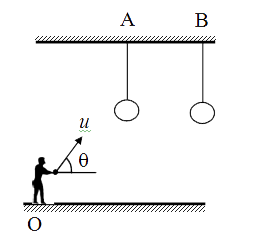
When the ball lands on the floor, the stop watch reads:
View SolutionTwo rings are suspended from the points A and B on the ceiling of a room with the help of strings of length 1.2 m each as shown. The points A and B are separated from each other by a distance AB = 1.2 m. A boy standing on the floor throws a small ball so that it passes through the two rings whose diameter is slightly greater than the ball. At the moment when the boy throws the ball, his hand is at a height of 1.0 m above the floor. A stop watch which is switched on at the moment of throwing the ball reads 0.2 s when the ball passes through the first ring and 0.6 s when it passes through the second ring.
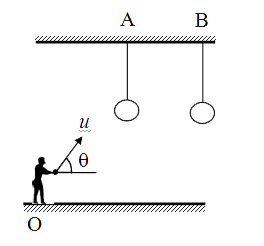
The ball lands on the floor at a distance:
View SolutionTwo rings are suspended from the points A and B on the ceiling of a room with the help of strings of length 1.2 m each as shown. The points A and B are separated from each other by a distance AB = 1.2 m. A boy standing on the floor throws a small ball so that it passes through the two rings whose diameter is slightly greater than the ball. At the moment when the boy throws the ball, his hand is at a height of 1.0 m above the floor. A stop watch which is switched on at the moment of throwing the ball reads 0.2 s when the ball passes through the first ring and 0.6 s when it passes through the second ring.
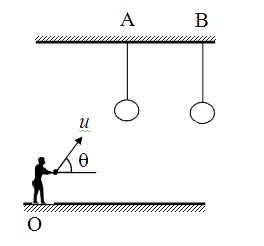
The angle of projection of the ball is:
View SolutionTwo rings are suspended from the points A and B on the ceiling of a room with the help of strings of length 1.2 m each as shown. The points A and B are separated from each other by a distance AB = 1.2 m. A boy standing on the floor throws a small ball so that it passes through the two rings whose diameter is slightly greater than the ball. At the moment when the boy throws the ball, his hand is at a height of 1.0 m above the floor. A stop watch which is switched on at the moment of throwing the ball reads 0.2 s when the ball passes through the first ring and 0.6 s when it passes through the second ring.
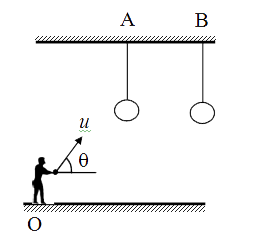
The maximum height attained by the ball above the floor is:
View SolutionTwo rings are suspended from the points A and B on the ceiling of a room with the help of strings of length 1.2 m each as shown. The points A and B are separated from each other by a distance AB = 1.2 m. A boy standing on the floor throws a small ball so that it passes through the two rings whose diameter is slightly greater than the ball. At the moment when the boy throws the ball, his hand is at a height of 1.0 m above the floor. A stop watch which is switched on at the moment of throwing the ball reads 0.2 s when the ball passes through the first ring and 0.6 s when it passes through the second ring.
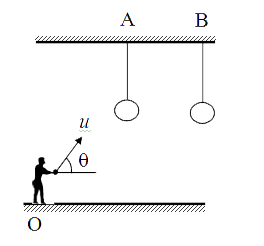
The projection speed of the ball is:
View SolutionTwo rings are suspended from the points A and B on the ceiling of a room with the help of strings of length 1.2 m each as shown. The points A and B are separated from each other by a distance AB = 1.2 m. A boy standing on the floor throws a small ball so that it passes through the two rings whose diameter is slightly greater than the ball. At the moment when the boy throws the ball, his hand is at a height of 1.0 m above the floor. A stop watch which is switched on at the moment of throwing the ball reads 0.2 s when the ball passes through the first ring and 0.6 s when it passes through the second ring.

The projection speed of the ball is:
View SolutionRead the following passage carefully and answer the questions that follow:
Attending classes inside a railway carriage seemed unusual enough, but the seating arrangements turned out to be unusual, too. At Totto-chan.s previous school each pupil was assigned a specific desk. But here they could sit anywhere they liked at any time.
The most unusual thing of all about this school, however, was the lessons themselves. Schools normally schedule one subject, for example history, during the first period, when everyone in the class just did history, then say arithmetic in the second period, when you just did arithmetic. But here it was quite different. At the beginning of the first period, the teacher made a list of all the problems and questions in the subjects to be studied that day. Then she would say, "Now, start with any of these you like".
So, whether you started on history or arithmetic or something else didn.t matter at all. Someone who liked composition might be writing something, while behind you someone who liked chemistry might be boiling something in a flask over an alcohol burner. This method of teaching enabled the teachers to observe-as the children progressed to higher grades- what they were interested in as well as their way of thinking and their character. It was an ideal way for teachers to really get to know their pupils.
As for the pupils, they loved being able to start with their favourite subject, the fact that they had all day to cope with the subjects they disliked meant they could usually manage them somehow. So, study was mostly independent, with pupils free to go and consult the teacher whenever necessary. Then pupils would be given further exercises to work at alone. It was study in the truest sense of the word, and it meant there were no pupils just sitting inattentively while the teacher talked and explained.
The first-grade pupils hadn.t quite reached the stage of independent study, but even they were allowed to start with any subject they wanted. Some copied letters of the alphabet, some drew pictures, some read books, and some even did physical exercises.
Just then the boy sitting behind her got up and walked toward the blackboard with this notebook, apparently to consult the teacher. Totto-chan stopped looking around the room and fixed her eyes on his back as he walked. The boy dragged his leg, and his whole body swayed from side to side, Totto chan wondered at first if he was doing it on purpose, but she soon realized the boy couldn.t help it.
The boy said brightly, "My name.s Yasuaki. What.s yours?" She was so glad to hear him speak that she replied loudly, "I.m Totto chan".
Give the meaning of the following words as used in the passage:
One-word answers or short phrases will be accepted.
assigned
View SolutionRead the following passage carefully and answer the questions that follow:
Attending classes inside a railway carriage seemed unusual enough, but the seating arrangements turned out to be unusual, too. At Totto-chan.s previous school each pupil was assigned a specific desk. But here they could sit anywhere they liked at any time.
The most unusual thing of all about this school, however, was the lessons themselves. Schools normally schedule one subject, for example history, during the first period, when everyone in the class just did history, then say arithmetic in the second period, when you just did arithmetic. But here it was quite different. At the beginning of the first period, the teacher made a list of all the problems and questions in the subjects to be studied that day. Then she would say, "Now, start with any of these you like".
So, whether you started on history or arithmetic or something else didn.t matter at all. Someone who liked composition might be writing something, while behind you someone who liked chemistry might be boiling something in a flask over an alcohol burner. This method of teaching enabled the teachers to observe-as the children progressed to higher grades- what they were interested in as well as their way of thinking and their character. It was an ideal way for teachers to really get to know their pupils.
As for the pupils, they loved being able to start with their favourite subject, the fact that they had all day to cope with the subjects they disliked meant they could usually manage them somehow. So, study was mostly independent, with pupils free to go and consult the teacher whenever necessary. Then pupils would be given further exercises to work at alone. It was study in the truest sense of the word, and it meant there were no pupils just sitting inattentively while the teacher talked and explained.
The first-grade pupils hadn.t quite reached the stage of independent study, but even they were allowed to start with any subject they wanted. Some copied letters of the alphabet, some drew pictures, some read books, and some even did physical exercises.
Just then the boy sitting behind her got up and walked toward the blackboard with this notebook, apparently to consult the teacher. Totto-chan stopped looking around the room and fixed her eyes on his back as he walked. The boy dragged his leg, and his whole body swayed from side to side, Totto chan wondered at first if he was doing it on purpose, but she soon realized the boy couldn.t help it.
The boy said brightly, "My name.s Yasuaki. What.s yours?" She was so glad to hear him speak that she replied loudly, "I.m Totto chan".
Give the meaning of the following words as used in the passage:
One-word answers or short phrases will be accepted.
independent
View SolutionRead the following passage carefully and answer the questions that follow:
Attending classes inside a railway carriage seemed unusual enough, but the seating arrangements turned out to be unusual, too. At Totto-chan.s previous school each pupil was assigned a specific desk. But here they could sit anywhere they liked at any time.
The most unusual thing of all about this school, however, was the lessons themselves. Schools normally schedule one subject, for example history, during the first period, when everyone in the class just did history, then say arithmetic in the second period, when you just did arithmetic. But here it was quite different. At the beginning of the first period, the teacher made a list of all the problems and questions in the subjects to be studied that day. Then she would say, "Now, start with any of these you like".
So, whether you started on history or arithmetic or something else didn.t matter at all. Someone who liked composition might be writing something, while behind you someone who liked chemistry might be boiling something in a flask over an alcohol burner. This method of teaching enabled the teachers to observe-as the children progressed to higher grades- what they were interested in as well as their way of thinking and their character. It was an ideal way for teachers to really get to know their pupils.
As for the pupils, they loved being able to start with their favourite subject, the fact that they had all day to cope with the subjects they disliked meant they could usually manage them somehow. So, study was mostly independent, with pupils free to go and consult the teacher whenever necessary. Then pupils would be given further exercises to work at alone. It was study in the truest sense of the word, and it meant there were no pupils just sitting inattentively while the teacher talked and explained.
The first-grade pupils hadn.t quite reached the stage of independent study, but even they were allowed to start with any subject they wanted. Some copied letters of the alphabet, some drew pictures, some read books, and some even did physical exercises.
Just then the boy sitting behind her got up and walked toward the blackboard with this notebook, apparently to consult the teacher. Totto-chan stopped looking around the room and fixed her eyes on his back as he walked. The boy dragged his leg, and his whole body swayed from side to side, Totto chan wondered at first if he was doing it on purpose, but she soon realized the boy couldn.t help it.
The boy said brightly, "My name.s Yasuaki. What.s yours?" She was so glad to hear him speak that she replied loudly, "I.m Totto chan".
Give the meaning of the following words as used in the passage:
One-word answers or short phrases will be accepted.
ideal
View Solution

